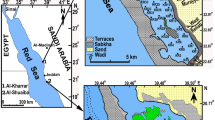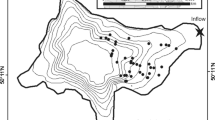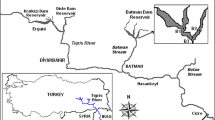Abstract
A total of 512 samples collected from 86 Hungarian water bodies were analyzed for Dinophyta species and compared to common limnological characteristics. Temperature and organic matter content were the most important factors controlling the occurrence of Dinophyta species. Total phosphorus and conductivity were of lesser importance. On average, seven to eight taxa of Dinophyta were recorded in individual samples at a temperature of 12–18 °C and a CODMn < than 5 mg l−1. Usually five to seven Dinophyta taxa were recorded at a temperature of 22–26 °C and CODMn > than 10 mg l−1. The most important genera were Peridiniopsis, Cleistoperidinium and Ceratium. A two-factor principal component model explained 72% of the total variance within the data set. The first principal component explained 75 and 85% of the total variance within the temperature and organic matter variables. A cluster analysis, using within-group linkages, resulted in five groups of organisms that differed primarily with respect to their distribution along a temperature gradient.
Similar content being viewed by others
References
Ács, É. & K. Buczkó, 1996. The changes of relative importance value of periphytic algal taxa in Szigetköz section of River Danube (Hungary). 31. Arbeitstagung der Internationale Association für Donauforschung, Baja, Ungarn. 441–446.
Borics, G., B. Tóthmérész, I. Grigorszky, J. Padisák & G. Várbiró, 2003. Algal assemblage types of bog-lakes in Hungary and their relation to water chemistry, hydrological conditions and habitat diversity. Hydrobiologia 502: 145–155.
Darkin, W. J. & M. Latarche, 1913. The plankton of Lough Neagh: a study of the seasonal changes in the phytoplankton by quantitative methods. Proc. R. Irish Acad. 30B: 20–96.
Gligora, M., A. Plenkovi´c-Moraj & I. Ternjej, 2003. Seasonal distribution and morphological changes of Ceratium hirundinella in two medirerranean shallow lakes. Hydrobiologia 506–509: 213–220.
Grigorszky, I., F. Vasas & G. Borics, 1999. [A páncélos-ostoros algák (Dinophyta) kishatározója [Guide book of Dinophyta species]. Környezetgazdálkodási Intézet, Budapest. 220 pp. [In Hungarian with English summary]
Hecky, R. E., E. J. Free, H. Kling & J. W. M. Rudd, 1978. Studies on the planktonic ecology of Lake Tanganyika. Can. J. Fish.Mar. Spec. Techn. Rep. 816.
Interlandi, S. J. & S. S. Kilham, 1999. Responses of phytoplankton to varied resource availability in large lakes of the Greater Yellowstone Ecosystem. Limnol. Oceanogr. 44: 668–682.
Jeppesen, E., J. P. Jensen, M. Sondergeerd, T. Lauridsen & F. Landkildehus, 2000. Trophic structure, species richness and biodiversity in Danish lakes: changes along a phosphorus gradient. Freshwat. Biol. 45: 201–218.
Kiss, K. T., É. Ács, K. Barkács, G. Borics, B. Böddi, L. Ector, G. K. Solymos, K. Szabó, A. Varga & I. Varga, 2002. Qualitative short-term effect of cyanide and heavy metal pollution on phytoplankton and periphyton in the Rivers Tisza and Szamos (Hungary). Arch. Hydrobiol. Suppl. Large Rivers 13: 47–72.
Komarovsky, A.1959. The plankton of Lake Tiberias. Bull. Sea Fish. Res. Stat. Haifa 25: 65–96.
Lee, G. F., P. E. Jones & R. A. Jones, 1991. Effects of eutrophication on fisheries. Rev. Aquat. Sci. 5: 287–305.
Lind, E., 1968. Notes on the distribution of phytoplankton in some Kenya waters. Br. Phycol. Bull. 3: 481–493.
Nõges, P., T. Nõges, L. Turikene, H. Smal, S. Lig¸eza, R. Kornijõw, W. P¸eczuta, E. Bécares, F. Garcia-Criado, C. Alvarez-Carrera, C. Fernandez-Alaez, C. Ferriol, R. M. Miracle, E. Vicente, S. Romo, E. Van Donk, W. van de Bund, J. P. Jensen, E. M. Gross, L.-A. Hansson, M. Gyllström, M. Nykänen, E. de Eyto, K. Irvine, D. Stephen, S. Collings & B. Moss, 2003. Factors controlling hydrochemical and trophic variables in 86 shallow lakes in Europe. Hydrobiologia 506–509: 51–58.
Nörusis, M. J., 1985. SPSSX. Advanced Statistics Guide. McGraw-Hill, New York. 212 pp.
Padisák, J., É. Ács, M. Rajczy & K. T. Kiss, 1991. Use of algae for monitoring rivers in Hungary. In: Whitton, B. A., E. Rott Friedrich, G. (eds), Use of Algae for Monitoring Rivers. Institut für Botanik, Universität Innsbruck: 123–128.
Padisák, J., G. Borics, G. Fehér, I. Grigorszky, I. Oldal, A. Schmidt & Z. Zámbóné-Doma, 2003. Dominant species, functional assemblages and frequency of equilibrium phases in late summer phytoplankton assemblages in Hungarian small shallow lakes. Hydrobiologia, 502
Pollingher, U., 1986. Freshwater armored dinoflagellates: growth, reproduction strategies and population dynamics. In Sandgren, C. D. (ed.), Growth and Reproductive Strategies of Freshwater Phytoplankton. Cambridge University Press, Cambridge: 134–174.
Popovsky J. & L. A. Pfiester, 1990. Dinophyceae (Dinoflagellida). Süsswasserflora von Mitteleuropa Band 6. Gustav Fischer, Stuttgart. 272 pp.
Reynolds, C. S., V. Huszar, C. Kruk, L. Naselli-Flores & S. Melo, 2002. Towards a functional classification of the freshwater phytoplankton. J. Plankton Res. 24: 417–428.
Rodrigo, M. A., C. Rojo & X. Armengol, 2003. Plankton biodiversity in a landscape of shallow water bodies (Mediterranean coast, Spain). Hydrobiologia 506–509: 317–326.
Tóthmérész, B., 1993. NuCoSA 1.0: Number cruncher for Community Studies and other ecological applications. Abstr. Bot. 7, 283–287.
Utermöhl, H., 1958. Zur Verwollkommnung der quantitative Phytoplankton Metodik. Mitteil. int. Ver. Limnol. 9: 1–38.
Woloszynska, J., 1914. Studien über das Phytoplankton des Victoria Sees. Hedwigia 55: 184–223.
Author information
Authors and Affiliations
Rights and permissions
About this article
Cite this article
Grigorszky, I., Borics, G., Padisák, J. et al. Factors controlling the occurrence of Dinophyta species in Hungary. Hydrobiologia 506, 203–207 (2003). https://doi.org/10.1023/B:HYDR.0000008552.60232.68
Issue Date:
DOI: https://doi.org/10.1023/B:HYDR.0000008552.60232.68




